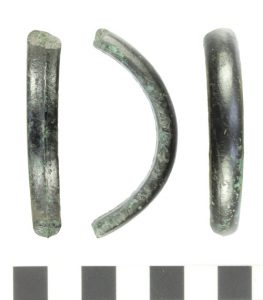HOARD 961029
Description: 2019 T608; undergoing valuation
Description: A group of three Bronze Age copper alloy arm bracelets/armrings.
A copper alloy bracelet/armring, consisting of a copper alloy bar bent around into a loop with slightly overlapping terminals. Undecorated and lozengiform in cross section, tapering at either end into unelaborated terminals.
Diameter 80.8mm; width 7.2mm; thickness 5.6mm; weight 46.06g.
A fragment of a copper alloy bracelet/armring, representing one terminal and part of the loop. The fragment consists of a bar of copper alloy, curved in profile, truncated by a fresh break at one end. Undecorated and plano-convex in cross section, with a prominent casting seam on the interior face and on the terminal. The terminal is unelaborated and sub-rectangular.
Length 60.8mm; width 10.1mm; thickness 6.6mm; weight 28.32g.
A copper alloy bracelet/armring, consisting of a copper alloy bar bent around into a loop, now sub-oval in plan and bent out of shape. Undecorated with a lozengiform cross section, with slightly expanded pad-like terminals.
Width across loop 93.9mm; width 7.8mm; thickness 6.8mm; weight 44.31g.
Discussion:
The bracelets/armrings described above can be best paralleled by objects from Ornament Horizon hoards of the Taunton phase (c.1400-1300 BC). During this phase many bracelets are more elaborate in the form or decoration (e.g. Rowlands 1971), and the Rockbourne examples are plain. They are, nevertheless, well paralleled by finds from the Monkswood hoard, Somerset (Smith 1959, Inv Arch GB. 42 2(1) & 2(2), see nos. 3-7), the Brading Marsh hoard (Isle of Wight), Hampshire (Rowlands 1976, 238), and Ebbesbourne Wake hoard, Wiltshire (Rowlands 1976, 271-21). For wider discussion of the ornament horizon and deposition of bracelets/armrings see Roberts (2007) and Wilkin (2017).
Only fragments 1 & 2 have precise find spots, with these being very widely dispersed within the same field. Despite this, it is unlikely that three bronze age armlets of similar form would be separately deposited within such a small area, and on the balance of probability the group either represent a hoard disturbed by later cultivation, or were deposited as part of the same process.
Conclusion:
As a find of three copper alloy objects of prehistoric date, objects Nos. 1-3 qualify as Treasure under the stipulations of the Treasure Act 1996 (Designation Order 2002)
Wil Partridge
Finds Liaison Officer for Wiltshire
July 2019
Checked and edited:
Neil Wilkin, Curator, British Museum
August 2019
Date: -1400 - -1300
Object type: HOARD
Last import: September 22, 2022


